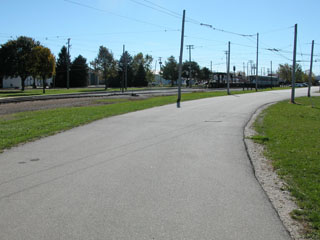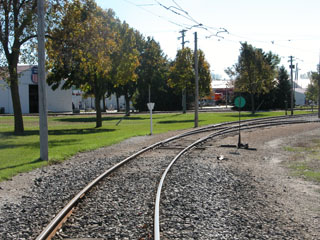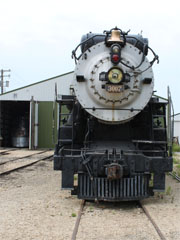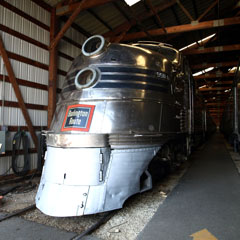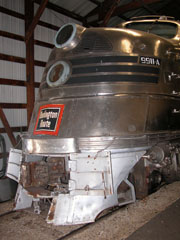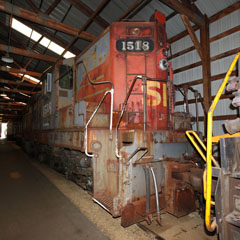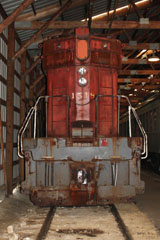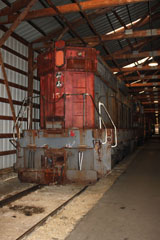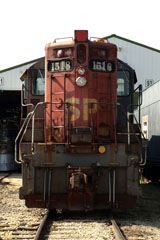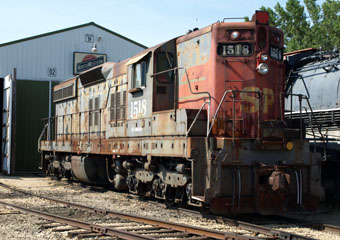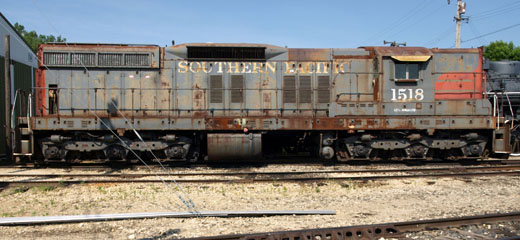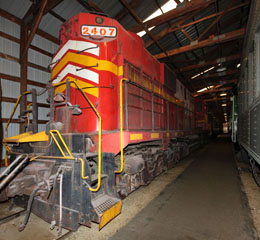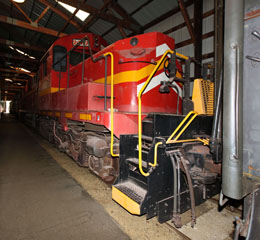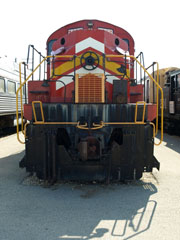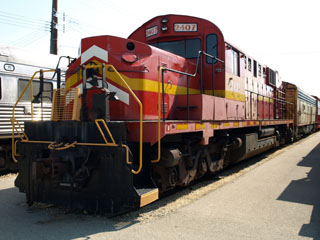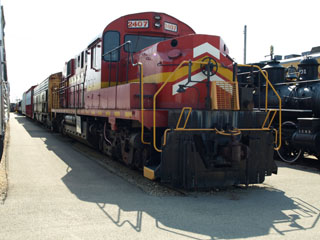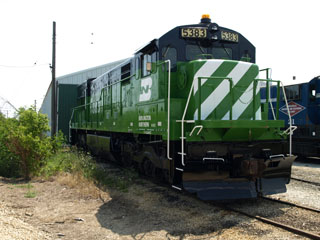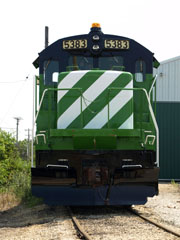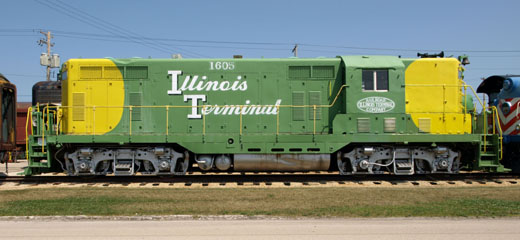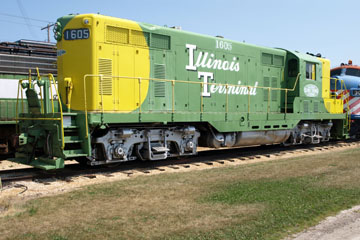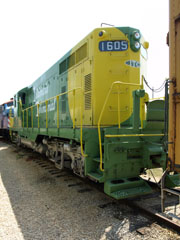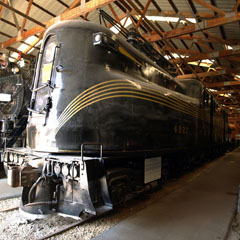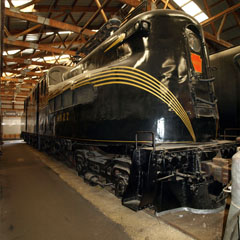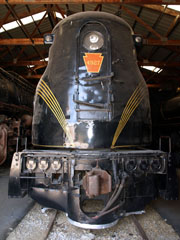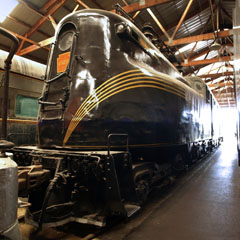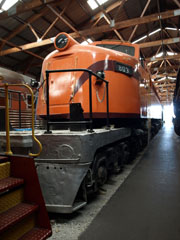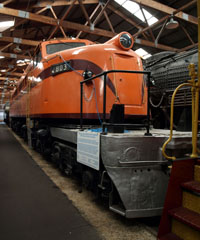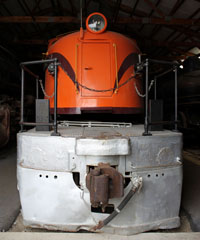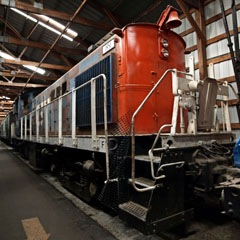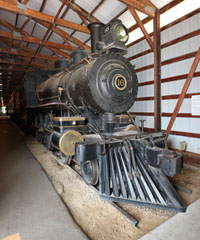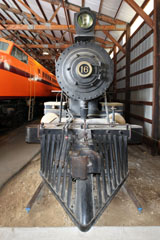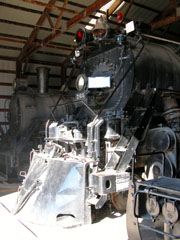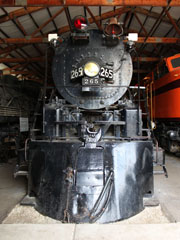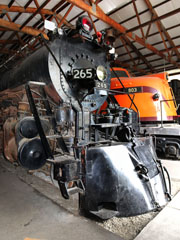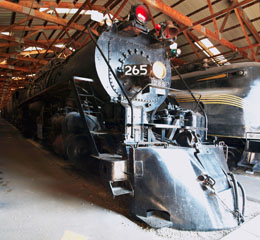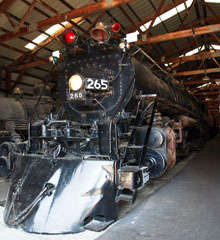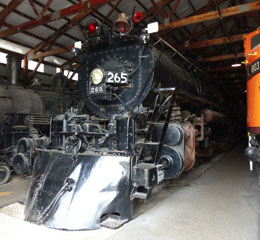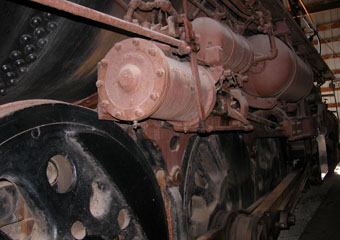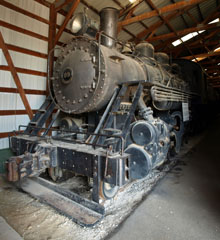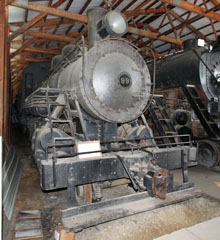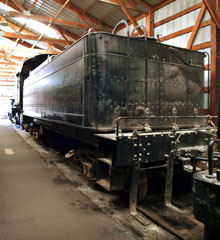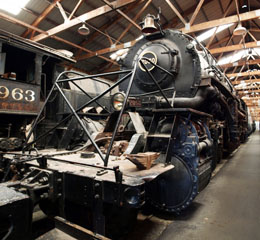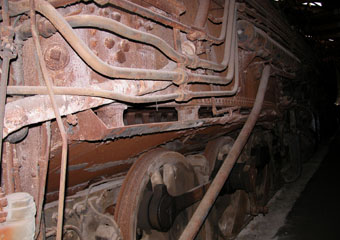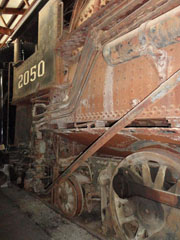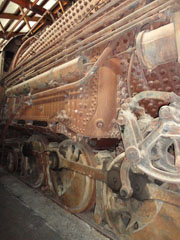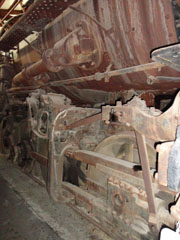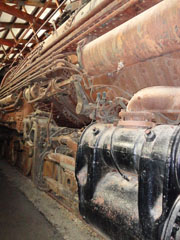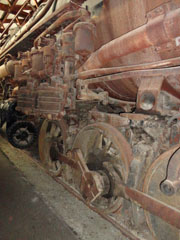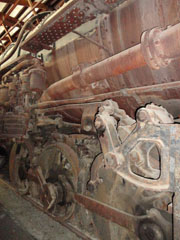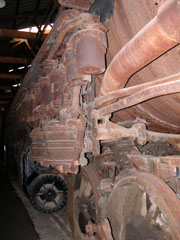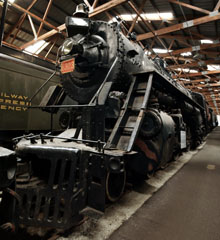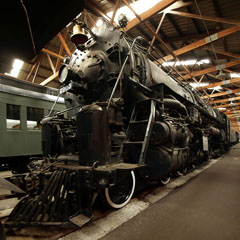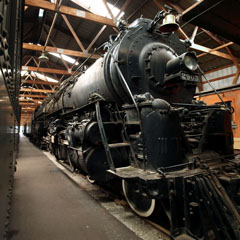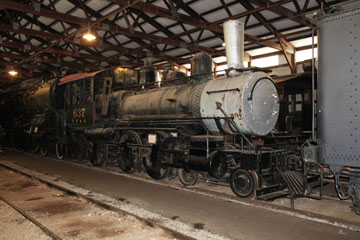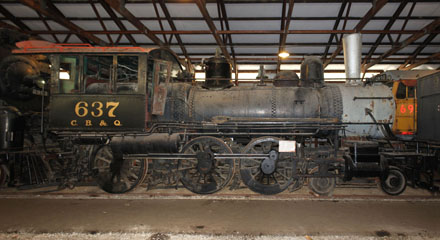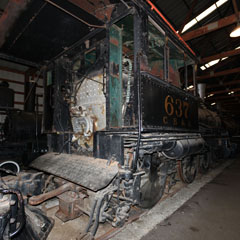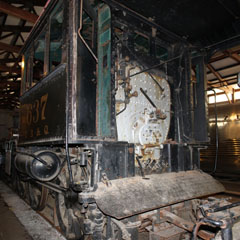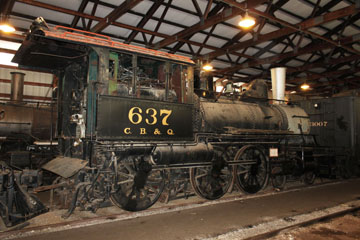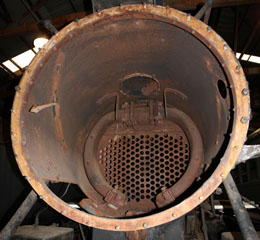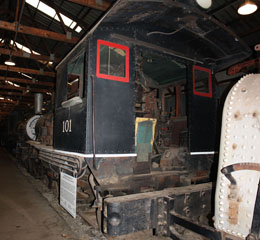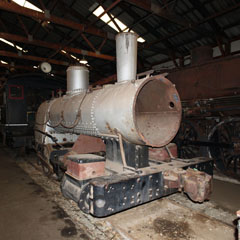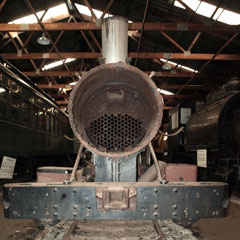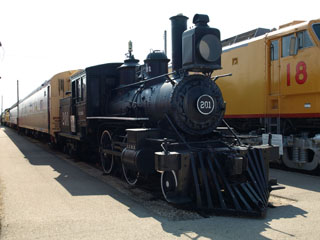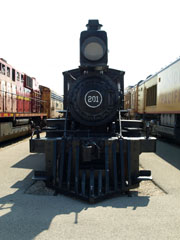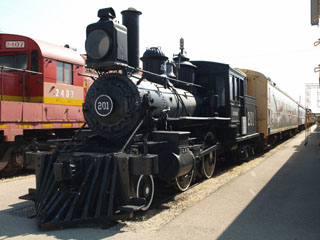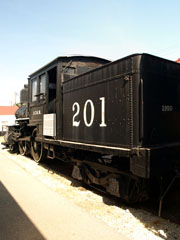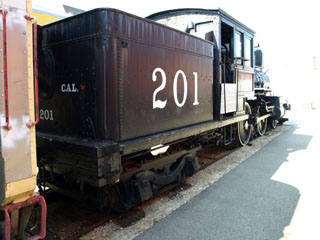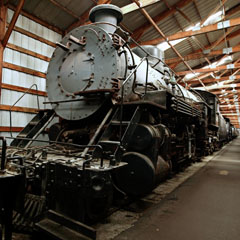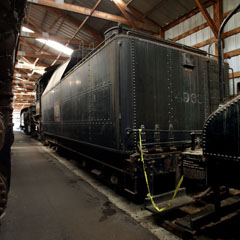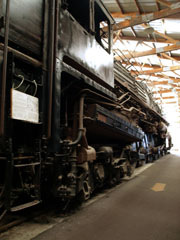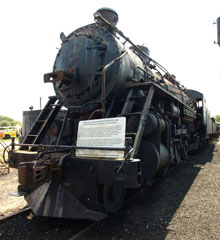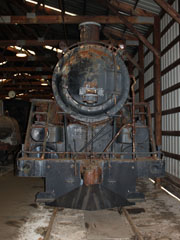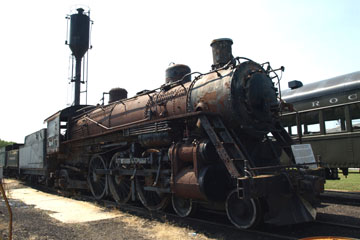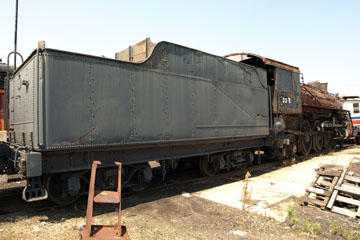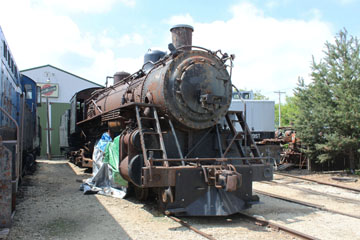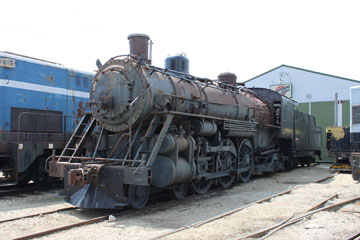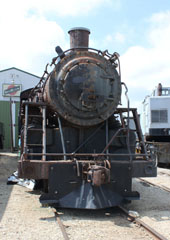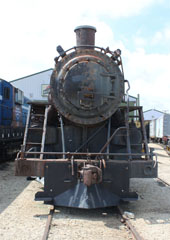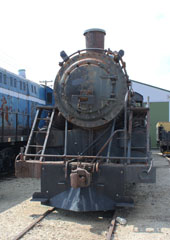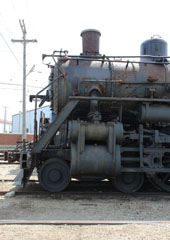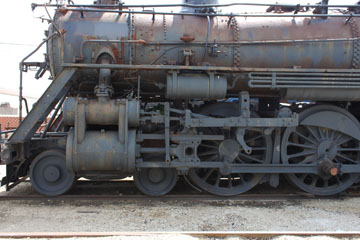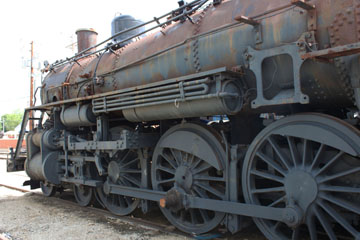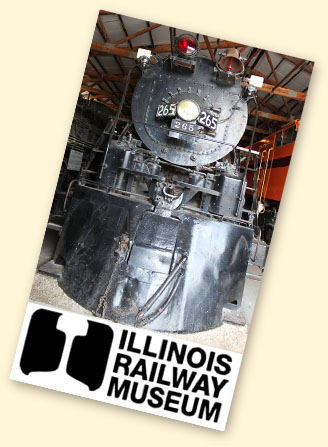

The Illinois Railway Museum is located at 7000 Olson Rd about a mile east of the small township of Union, IL, and about
fifty-five miles from central Chicago.
The museum was started in 1953 by a group of volunteers who bought Indiana Railroad interurban car #65. It is now the largest railroad museum in the US and, because of its size, I have split the collection over two pages. This page shows locomotives in Barn 9, the main Train Shed. The second, much larger Illinois Railway Museum Yard page shows equipment on display outdoors.
I have been to the museum several times and the photos are from various visits.

The museum has ten equipment storage
barns, which include displays of passenger, rapid transit and interurban cars. It also has a dedicated steam restoration shop, an 1853 train depot, a complete Chicago Rapid Transit Company elevated station, four streetcar stations of different designs and an indoor dining facility.
Below, CBQ S-4 Hudson (4-6-4) type #3007
outside the train shed (you can see more photos of #3007 on the Illinois Railway Museum Yard page of this website). CBQ EMD E5 #9911 peeks out at the open door of Bay 91 of Barn 9 on the left.
Originally called the Illinois Electric Railway Museum, the name was changed to Illinois Railway Museum in 1961 to reflect its expanding collection. Initially located on the grounds of the Chicago Hardware Foundry in North Chicago, IL, in 1964, the entire collection was moved to its current site along the former right-of-way of the Elgin & Belvidere interurban.
Above, the museum still runs electric trains and interurbans April-October, and diesel and steam trains May to September.

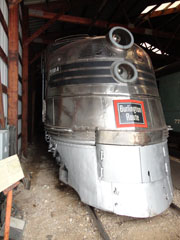
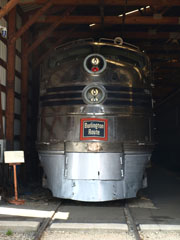
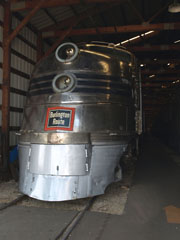
Above, like much of the equipment in the train shed, it can be difficult to get good photographs of #9911.
This is the only surviving EMD E5 diesel, sixteen of which were built for the Chicago, Burlington & Quincy and its subsidiaries during 1940 and 1941. It was distinguished from the E3, E4 and E6 units by its polished stainless steel cladding, which matched the Burlington's Zephyr trains (you can see the first Zephyr on the Museum of Science and Industry Chicago page of this website).
Eleven 71' 1" long A units weighing 315,000 lbs and five B units weighing 290,000 lbs were built. They had two 567 12 cylinder prime movers powering two GM D4 generators to drive four GM D7 traction motors. Delivering 31,000 lbs continuous tractive effort at 11 mph, they had a top speed of 116 mph.
As Silver Pilot, #9911 was last used on the Fort Worth & Denver Railway (a CB&Q subsidiary) on the Texas Zephyr. It was retired in the late 1960s, and now runs on museum trackage as well as, occasionally, main line runs coupled to one of CB&Q's original five car Nebraska Zephyr trainsets.

Weighing 360,000 lbs and 60' 8" long, its 1,500 hp 567B 16 cylinder prime mover powered six GM D47 traction motors, one on each axle.
Delivering 75,000 lbs continuous tractive effort at 9.3 mph, #1518 had a top speed of 65 mph.
Above, when I last visited, SP EMD SD7 #1518 was in the train shed. Right, on an earlier visit, it was standing out in the yard.
Built as Demonstrator #990 in 1951, this was the first of EMD's SD ("Special Duties") series units, later models of which are still being produced. One hundred and eighty-eight SD7s were built between 1952 and 1953, all for US railroads. #990 demonstrated on several railroads before being bought by the SP in October 1952 and renumbered #5308. It underwent a series of number changes before being rebuilt as an SD7R in 1980 when it became #1518.
The Union Pacific took control of the SP in 1996 and retired #1518 the following year. It was kept at the Cheyenne, WY, roundhouse until donated to the museum in 2003.

The RSD-15 could be ordered with either a high or low short hood. However, the majority were built with a low short hood like the one on #2407.
Railfans dubbed the low short hood units "Alligators" because of their unusually long low noses.
The AT&SF bought fifty RSD-15s, the largest number of any railroad, so it's not surprising all six survivors are ex-AT&SF.
Renumbered ATSF #9841, this unit became Lake Superior & Ishpeming Railroad #2402 in 1975 and then Green Bay & Western #2407 in 1989. Retired in 1993 when the GB&W merged into the Wisconsin Central, it was sold to the museum in 1996. You can see another RSD-15 Utah Railway #401 (ex ATSF #823) on the Ogden Union Station page of this website.
Above, Green Bay & Western Alco built RSD-15 #2407 was also in the train shed when I last visited but, right, on an earlier visit, it was out in the yard.
The unit was delivered to the AT&SF as #841 in 1959, one of seventy-five, all built for US railroads from 1956 to 1960. With a 4-cycle Model 251B V16 prime mover powering a GE GT586 generator to drive six GE 752 traction motors, it weighs 335,000 lbs and is 66' 7" long. Delivering 79,500 lbs continuous tractive effort at 12 mph, it had a top speed of 65 mph. The three-axle Trimount trucks had an asymmetrical axle spacing because of the positioning of the traction motors, but allowed higher tractive effort at lower speeds than a similar four-motor design.

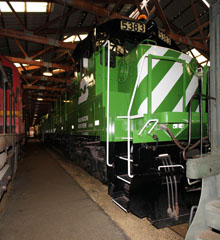
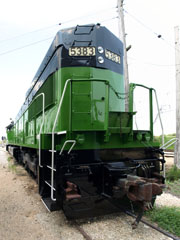
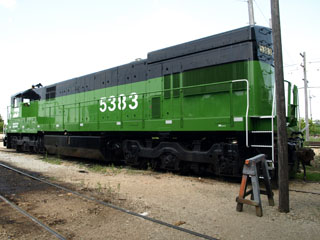
Above, another unit, BN GE U30C #5383, was in the shed when I last visited but was previously out in the yard.
GE built five hundred and ninety-six U30Cs from 1966 to 1976. Except for eight for the Ferrocarril del Pacifico, they were all bought by US customers. DOT #001 served as power for the Dept of Transportation's subway car test tracks in Pueblo, CO, (you can see it on the Pueblo Railway Museum page of this website).
The 67' 3" long units weigh 363,000 lbs. With a 4-cycle Model FDL-12T prime mover powering a GE GTA-11 generator to drive six GE 752 traction motors, they delivered 92,500 lbs continuous tractive effort at 10.7 mph with a top speed of 70 mph.

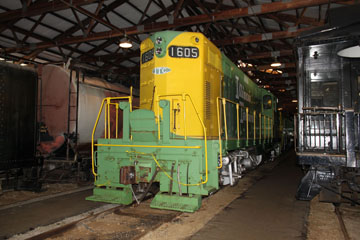
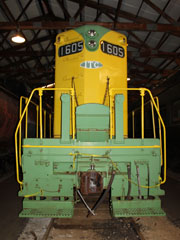
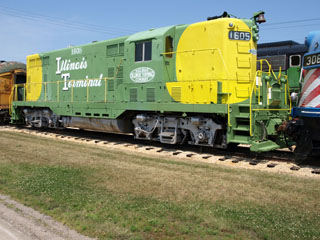
Illinois Terminal Railroad EMD GP7 #1605 was also in the shed but on display in the yard on an earlier visit. It is one of six GP7s bought by the ITC in 1953.
The GP7 was astoundingly successful. Two thousand, seven hundred and twenty-nine were built from 1949 to 1954, two thousand, six hundred and fifteen for US railroads, one hundred and twelve for Canadian and two for Mexican railroads. Extremely versatile, they hauled freight and passenger services, as well as operating as switchers.
The GP7 was the first EMD road locomotive to use a hood unit instead of a car-body design. With an EMD 567B 16 cylinder prime mover powering a GM D12 generator to drive four GM-D27B traction motors, they delivered 40,000 lbs continuous tractive effort at 9.3 mph with a top speed of 65 mph.
You can see other GP7s on the Gold Coast Railroad Museum page of this website, the B&O Railroad Museum Yard & Car Shop, Crewe Railroad Museum and Virginia Museum of Transportation pages.

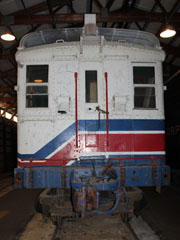
Built in 1926, Delaware, Lackawanna & Western #3001 was the fourth diesel-electric unit jointly produced by Alco, who built the chassis and running gear, GE, who supplied the electrical components, and Ingersoll Rand, who built the diesel engine.
Twenty-six units were built from 1925 to 1930 in both 60 ton and 100 ton versions. The 60 ton units like #3001 had a tractive effort of 37,200 lbs and top speed of 30 mph. The DL&W bought #3001 for its 25th Street Terminal in Brooklyn,
and a second (DLW #3002 renumbered Harlem Transfer #2) for its facility in the Bronx.
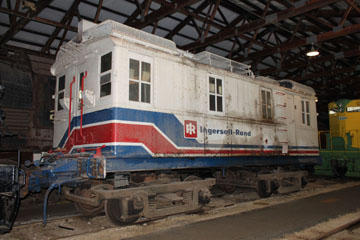
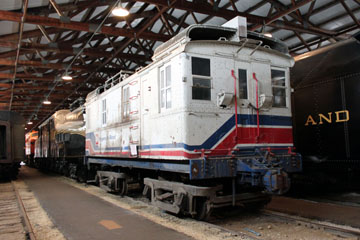
#3001 was sold back to Ingersoll Rand in 1951 and worked at Phillipsburg, NJ, as switcher #91. It was donated to the museum in 1984.
As well as DLW #3001 on this page, you can see Ingersoll Rand #90 on the Henry Ford Museum page and CNJ #1000 on the B&O Railroad Museum Roundhouse page of this website. BO #1/195/8000 is in the National Museum of Transportation, St. Louis Yard, the North Alabama Railroad Museum in Huntsville, AL, has Union Carbide #3/11 and the Western Pacific Railroad Museum in Portola, CA, has Foley Bros., #110-1.

PRR #4927 is a GG1 built by the Pennsylvania Railroad at its Juanita Shops in Altoona, PA in 1942.
The GG1 was designed to operate over the PRR's newly electrified Harrisburg-Philadelphia-
New York route. A pantograph mounted on each end of the unit collected an 11,000 V alternating current from overhead lines. Transformers located between the two cabs then stepped the voltage down for the unit's twelve 385 hp
GEA-627-A1 traction motors.
GG1s delivered 4,620 hp, but could reach 8,500 hp for short bursts.
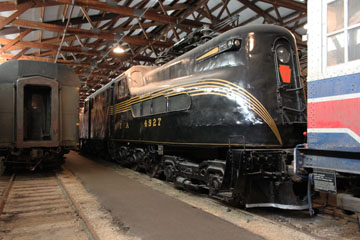
One hundred and thirty-nine GG1s were built from 1934 to 1943. The Pennsy ordered fourteen from General Electric but the remaining one hundred and twenty-five were built at Altoona.
They transferred to Pennsy's successor Penn Central in 1968, and forty were sold to Amtrak, including #4927 in 1976, when it became AMTK #4939. The rest operated on Penn Central's successor Conrail until 1979. Thirteen were then acquired by New Jersey Transit. Amtrak retired its GG1s in 1981, and #4927 was the last to operate on the Philadelphia-Harrisburg line. It moved to the museum in 1981 and was restored to a PRR black and gold livery in 1999.
Fifteen GG1s have been preserved, although none is operational. You can see the prototype, #4800 "Old Rivets", and find out more about the design on the Pennsylvania Railroad Museum Yard
page of this website. #4882 is on the National New York Central Museum page, #4890 on the National Railroad Museum page, #4903 on the Museum of the American Railroad page, #4919 on the Virginia Museum of Transportation page and #4935 on the Railroad Museum of Pennsylvania Train Shed
page.

#803 is one of twenty electric locomotives built by GE for export to the Soviet Union in 1946.
Designed to operate on Soviet Railways 3,300 volt DC overhead line system, GE were prohibited from delivering them because of deteriorating relations between the US and USSR during the Cold War.
Fourteen were built to
the 5' Russian gauge
and the last six to the
4' 8½" standard gauge.
These 545,600 lbs 88' 10" long twelve axle units were equipped with eight GE 750 traction motors and delivered 75,700 lbs tractive effort with a top speed of 68 mph.
Three of the units were sold to the Chicago South Shore & South Bend Railroad in 1949, five to the Companhia Paulista de Estradas de Ferro of Brazil and then twelve to the Milwaukee Road. They were dubbed "Little Joes" on the Milwaukee Road after Joseph Stalin but were known as 800s on the South Shore.
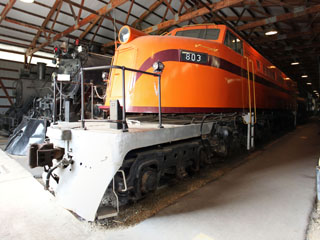
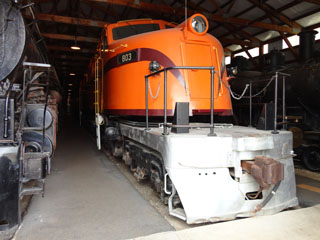
The South Shore, while primarily a commuter line between Chicago, IL, and South Bend, IN, converted the three 5,120 hp locomotives to 1,500 V power for freight service. Two survived until 1983, the last electrics in regular mainline freight service on a US common-carrier railroad.
#803 was donated to the museum in 1983. CSS #802 is now owned by the Baltimore & Ohio Railroad Museum, Baltimore, MD, and is on loan to the Lake Shore Railway Museum in North East Pennsylvania.

The first thirteen production RS-1s were requisitioned by the US Army and remanufactured into 6 axle RSD-1s for use on the Trans Iranian Railroad to supply the Soviet Union during WWII.
A number of RSD1 units have survived. TXIX RSD-1 #8000 is on the Museum of the American Railroad page of this website, USA RSD-1 #8651 on the National Railroad Museum page and ARR RSD-1 #1034 on the Railroad Museum of Pennsylvania Yard page.
It was particularly difficult to get good photographs of Alco built Grand Trunk Western RS-1 #1951 as it was parked up against an external wall.
Four hundred and sixty-nine of these 4 axle diesel electrics were built by Alco-GE between 1941 and 1953, and then by Alco from 1953 to 1960. The RS-1 had the longest production run of any diesel locomotive for the North American market, and its
carbody pioneered the road switcher type (the "RS" stood for road switcher). Most switchers since then have followed this basic design with the low hood and engine cowling.
#1951 was the last RS-1 produced for a US railroad. The remainder, built between 1957 and 1960, were all delivered to railroads operating in Mexico, Brazil and Saudi Arabia.
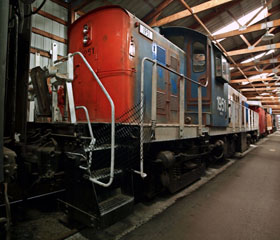
#1951 weighs 240,000 lbs with an Alco 539T prime mover powering a GE GT553C generator driving four GE 731 traction motors producing 35,000 lbs continuous tractive effort at 8 mph and a top speed of 60 mph.
You can see DSA RS-1 #101 on the Lake Superior Railroad Museum page of this website, GCOX RS-1 #106 on the Gold Coast Railroad Museum and RPCX Alco RS-1 #476 on the Hoosier Valley Railway Museum page.

This 4-4-0 American type locomotive was built by Baldwin in 1915 for the Midland Pennsylvania Railroad as #1 and named "T. E. Herrick". However, it was never delivered and was sold to the Toledo-Detroit Railroad.
In 1916, the Detroit, Toledo & Ironton Railroad leased the Toledo-Detroit and the locomotive became DTI #16. The line had gone bankrupt in 1908 but remained solvent until it was bought by Henry Ford in 1920.
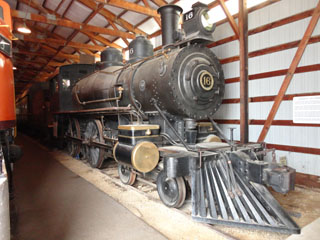
The line thrived and saw numerous improvements under Ford's management until 1929, when he sold it to the Penn Road Corporation, a subsidiary of the Pennsylvania Railroad.
In 1930, #16 was retired and donated to the Edison Institute of Dearborn, MI, and later appeared on display in the Henry Ford Museum. In 1983, the Illinois Railway Museum traded BLE 2-8-0 #154 for #16 (you can see BLE #154 on the Henry Ford Museum page of this website).

#265 weighs 460,000 lbs, 259,300 lbs on its drivers. All eight of its 74" Boxpok drivers have roller bearings and are fitted with compensating lateral driving-box devices. It has Walschaert valve gear and
26" x 36" cylinders.
#265 has an all-weather vestibuled cab, jacketed smokebox and solid cast pilot with retractable coupler.
S3 Class #265, a 4-8-4 Northern type locomotive, was built in July 1944 by Alco. It is one of ten that were the last steam locomotives delivered to the Milwaukee Road.
A coal burner with a 96.2 sq ft grate area, 505.5 sq ft firebox and total heating surface of 5,916 sq ft, including 1,438 sq ft superheating, it operated at a boiler pressure of 250 psi delivering tractive effort of 62,119 lbs.
#265 went into storage in 1954 as the Milwaukee Road ended steam operations. Three years later, it was donated to the city of Milwaukee, WI, where it went on open air display until donated to the museum in 1975.
It is one of only three Milwaukee Road steam locomotives to have survived the scrapper's torch.
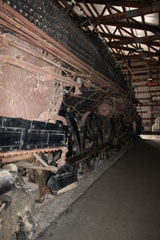
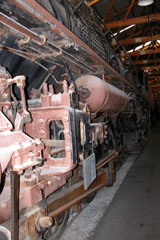
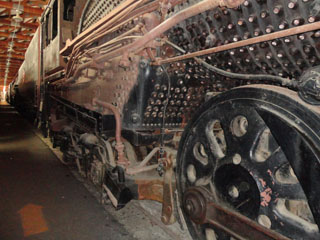
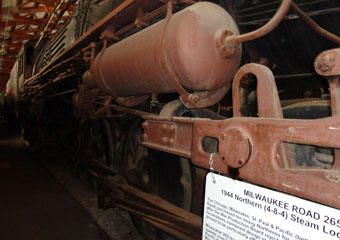
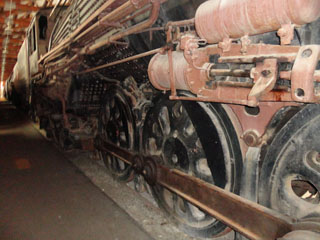
Clockwise from top left above, a view along the right side of the locomotive, valve gear, cross head and drive rods, the rear driver and trailing truck, two views of the power reverse, drivers and drive rods and, lastly, a view of one of the air reservoirs.
MILW S3 #261 has been restored to operating condition and runs excursions. You can see photos of my September 2008 trip from Milwaukee to La Crescent, MN, including riding on the footplate, on the MILW #261 page of this website.

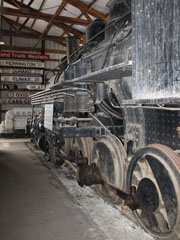
This 2-8-0 Consolidation locomotive was built by Baldwin in 1919 for the Louisiana Railway & Navigation Company, which merged into the Louisiana & Arkansas Railway in 1929.
#99 hauled freight and mixed trains on the railroad's New Orleans-Shreveport–Dallas line until bought by the West Feliciana Railway of San Francisville, LA, in 1946. Abandoned in a swamp in 1954, it was pulled out and donated to the museum in 1968.
#99 is an oil burner with 20" x 26" cylinders and 52" drivers. Operating at a boiler pressure of 180 psi it delivered 31,824 lbs tractive effort.

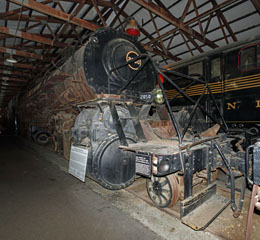
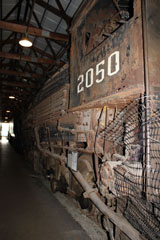
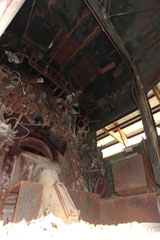
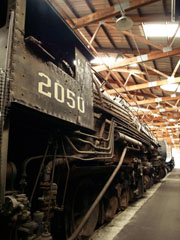
Inheriting fifty USRA 2-8-8-2s based on the Y2 design in 1919 (forty-five built by Alco, five by Baldwin), the N&W designated these as Y-3s. Thirty more 2-8-8-2s, designated Y-3a, were then built by Alco in 1923, including #2050.
#2050 weighs 539,000 lbs and has 57" drivers. The rear high pressure cylinders are 25" x 32", the front low pressure 39" x 32". With a 96 sq ft grate, 453 sq ft firebox and 7,335 sq ft heating surface, including 1,582 sq ft superheating, it operated at 270 psi delivering 114,148 lbs tractive effort.
Right, views of the firebox (note the ash pan recesses for the drivers), valve gear, cylinders and cross compound air pumps.
You can see another N&W compound 2-8-8-2, Y-6a #2156, on the National Museum of Transportation, St. Louis page of this website.
The Norfolk & Western developed its Y class from five 2-8-8-2 Y-1 locomotives built by Baldwin in 1910. Not particularly successful in operation, by 1924, these had all either been scrapped or converted to 0-8-8-0s for yard service.
Convinced of the utility of Mallets on its challenging mountainous profile, however, in 1918 the N&W turned out the first Y-2 2-8-8-2 from its Roanoke shops.

The CN and GTW Northerns were relatively light weight. #6323 weighs 403,000 lbs (245,000 lbs on its drivers) and has 26" x 30" cylinders and 73" drivers. With an 84.3 sq ft grate, 413 sq ft firebox and 6,357 sq ft heating surface, including 95 sq ft of thermic syphons and 1,955 sq ft superheating, it operated at 250 psi delivering 59,034 lbs tractive effort.
The Grand Trunk Western was one of the first US railroads to use 4-8-4 Northern type locomotives. As a subsidiary of the Canadian National
Railway, however, they were known as "Confederations", the first 4-8-4s having been delivered to the CN on the sixtieth anniversary of Canadian Confederation in 1927.
The GTW eventually rostered forty-three of this type. The first twelve Class U-3a locomotives were purchased from Alco in 1927
(#6300-#6311). Another six came from Lima in 1938 designated Class U-4 (#6405-#6410). Then, in 1942, Alco delivered the final twenty-five designated Class U-3c (#6312-#6336). Designed for passenger service, they also hauled fast freight trains.
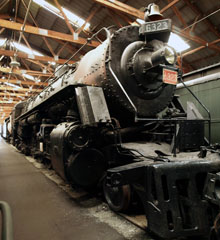
#6323 worked on both the CN and GTW systems, and had the distinction of being the last steam locomotive to haul a scheduled main line passenger service on the GTW from Detroit to Durand, MI, on 20th September 1961. Sold to Fred Crew later that year, then to IRM member Robert Johnson in 1973, the locomotive was acquired by the museum in 1994.

The 2900s hauled freight until WWII ended and were then assigned to the Scout and Grand Canyon Limited.
The engine has a 108 sq ft grate. Thermic syphons of 30.5 sq ft were fitted to the 479 sq ft firebox, which included 124 sq ft in an 84" long combustion chamber. With 2,366 sq ft of superheating, #2903 had a total heating surface of 7,678 sq ft.
The AT&SF bought sixty-five Northern type (4-8-4) locomotives between 1927 and 1944, all from Baldwin.
The last thirty (#2900-#2929) delivered in 1944 were based on the 3765 class built in 1938, but WWII materials restrictions meant some components had to be substituted. As a result, the 2900s were the heaviest Northerns ever built.
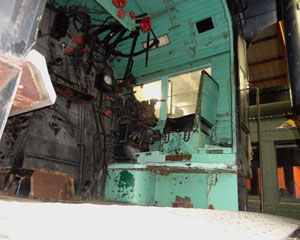
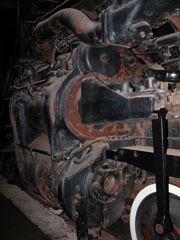
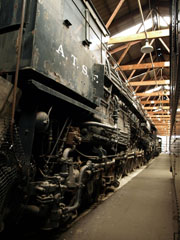
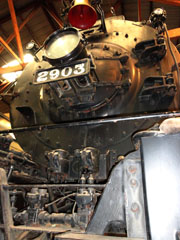
#2903 weighs 510,150 lbs, 293,860 lbs on its 80" drivers, and has
28" x 32" cylinders. An oil burner operating at a boiler pressure of 300 psi, the locomotive delivered 79,968 lbs tractive effort.
Another 2900 is on the ATSF #2913 page of this website.

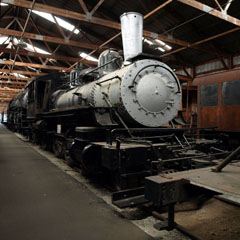
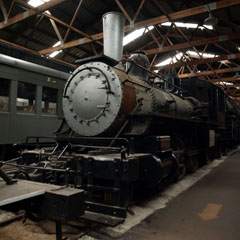
This Ten Wheeler (4-6-0) type coal burning engine was built in 1892 by the Rogers Locomotive Works in Paterson, NJ, (later part of Alco) as #309 for the Burlington & Missouri River Railroad headquartered in Omaha, NE.
The B&MRR was incorporated in Burlington, IA, in 1852 and started operations in 1856 with only a few miles of track.
The Burlington & Missouri River was developed to build a railroad across the state of Iowa and reached the Missouri River in November 1859.
After acquisition by the Burlington in 1872, the B&MRR continued as a separate operation until it was merged into the CB&Q in 1904. #309 was then renumbered #637 and formally joined the CB&Q roster.
#637 was soon relegated to branch line service and hauled commuter trains in the Chicago area until 1948.
It was displayed with a fake wood burning smokestack at the 1948 Chicago Railroad Fair and then hauled railfan excursions until 1956 when it was donated to the City of Aurora, IL. Twenty-four years later, it was sold to the museum.
With a 13' 6" driver wheelbase and engine wheelbase of
24' 7½", this Ten Wheeler (4-6-0) type coal burning
engine weighs 124,550 lbs, 100,750 on its 64" drivers. It
has 19” x 24” cylinders and 64” drivers. Operating at a boiler pressure of 180 psi, it delivered 20,712 lbs tractive effort.
Below, #637 has a 158.8 sq ft Belpaire firebox that slopes towards the front. The 1,892 sq ft heating surface included 16 sq ft of arch tubes. Also note the uneven driver spacing (5½’ between the leading and centre axles, 8’ between the centre and rear axles). The centre set of drivers is flangeless.

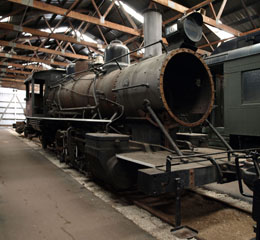
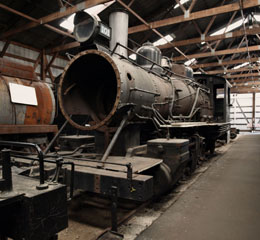
Built in 1924 by Baldwin for the Tuskegee Railroad as #101, this locomotive is typical of the light weight Prairie type (2-6-2) used on shortlines in the American South.
The Tuskegee operated five miles of track connecting the Western Railway of Alabama at Chehaw, AL, to the Tuskegee Normal & Industrial Institute (later Tuskegee University). #101 hauled mixed trains three times a day over the line.
An oil burner weighing 134,000 lbs, #101 has 17" x 24" cylinders and 43" drivers. Operating at a boiler pressure of 160 psi, it delivered 21,937 lbs tractive effort.
The locomotive was sold to the T. R. Miller Mill Co., in Brewton, AL, in 1953 as a switcher and then to Herbert Hansen in Union, IL, in 1969. When I visited, it was being overhauled for conversion to burn coal with its front pilot in storage.

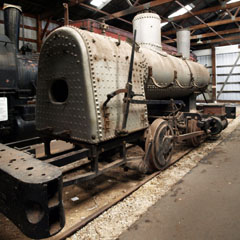
This locomotive is one of several switchers bought by the US Navy to work at the Brooklyn Naval Yard in New York. An 0-4-0T Tank locomotive, its small size made it ideal for the sharp curves and tight clearances in the yard.
Built by the Vulcan Iron Works of Wilkes Barre, PA, in 1917 as a
coal burner, #7 was later converted to burn oil. It has 37" drivers and 14" x 20" cylinders. Weighing 78,000 lbs and
operating at a boiler pressure of 100 psi, it delivered 16,200 lbs tractive effort.
Sold first to the scrap dealer Birmingham Rail & Locomotive Co., then to the American Creosote Works in Jackson, TN, as #7 in 1942, it was donated to the museum in 1965. It had been stripped of its tank and running gear when I visited and may eventually be returned to steam.

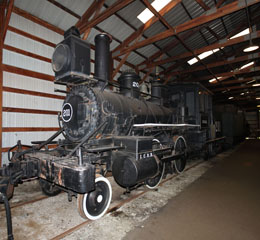
Above, Illinois Central Railroad #201 had been moved into the train shed when I last visited but, right, was previously out in the yard. It was built by Rogers (later part of Alco) in 1880 and is the oldest locomotive in the museum's collection.
Originally numbered #213, this was one of a large fleet of locomotives acquired by the IC for short haul commuter traffic in the Chicago
area. Weighing 107,600 lbs, it has
16" x 21" cylinders and 56½"
drivers. The grate is 12.7 sq ft and the firebox 98 sq ft. With 918 sq ft heating surface and operating at a boiler pressure of 140 psi, the locomotive delivered 11,862 lbs tractive effort.
#201 hauled thousands of passengers to the 1893 Columbian Exposition in Chicago, at which time, John Luther Jones (aka "Casey Jones") may have been one of its engineers.

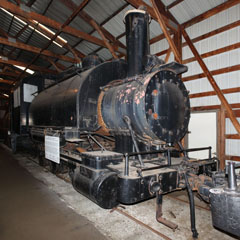
This 0-6-0T (Tank) was built as #7 by Baldwin in 1926 for the Public Service Co., of Northern Illinois at Waukegan, IL. It was the first steam locomotive donated to the museum in 1961.
A coal burner, #7 weighs 134,000 lbs and has 19" x 24" cylinders and 44" drivers. Operating at a boiler pressure of 180 psi, it delivered 30,100 lbs tractive effort.
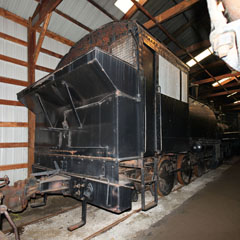

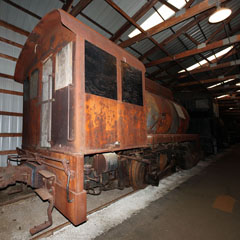
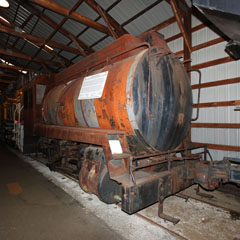
#4 was built by H. K. Porter in Pittsburgh, PA, in 1946 for the Union Electric power plant in Venice, IL. It switched at the plant until 1976 and was donated to the museum in 1982.
It is an 90,000 lb 0-4-0 fireless locomotive, powered by compressed steam, with 32" drivers and 22" x 18" cylinders. Fully charged at 350 psi, it could deliver 16,330 lbs tractive effort.

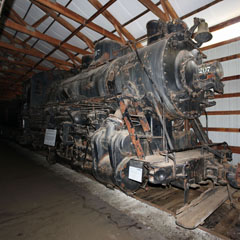
After WWI, the 0-6-0 was largely replaced by the 0-8-0 in new orders for switching locomotives. However, some companies, such as the Lehigh & New England did still purchase them. #207 was delivered from the Baldwin Locomotive Works in 1936. It is the railroad's only modern 0-6-0 and the sole L&NE steam locomotive to survive.
#207 weighs 183,900 lbs and has 51" drivers and 21" x 28" cylinders. With a 49 sq ft grate and 1,852 sq ft heating surface, including 485 sq ft superheating, it operated at a boiler pressure of 215 psi, delivering 44,200 lbs tractive effort.
The locomotive was sold to the Nicholson Terminal & Dock Co., at River Rouge, MI, and renumbered #14. An IRM member bought it in 1968 and it arrived at the museum in 1973.

#4963 weighs 316,780 lbs, 232,650 lbs on its 64" drivers, and has
27" x 30" cylinders. The 325 sq ft radially stayed firebox includes 33 sq ft of arch tubes and 59 sq
ft of combustion chamber. Adding the 769 sq ft superheating, the locomotive's total
heating surface was
4,178 sq ft.
The tender weighs 195,200 lbs light with a 10,000 gallon water and 19 ton coal capacity.
From 1961 to 1966,
#4963 worked for the Bevier & Southern in Bevier, MO, and then passed through a
number of owners before arriving at the museum in 1990.
By the time the CB&Q took delivery of #4963 in 1923, part of an order for sixty (#4940-#4999), it already had three hundred and eight Mikado type (2-8-2) locomotives on its roster.
The sixty 0-1A class Mikes were based on the earlier 0-1 class but with outside admission piston valves instead of inside, and tapered boilers in place of wagon tops.

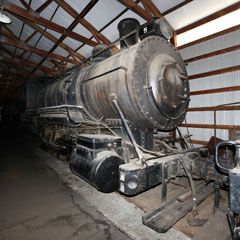
Although built in 1922, #5 is more typical of earlier 0-6-0 switchers with its long narrow firebox, saturated steam boiler and Stephenson valve gear. It was bought from Baldwin and worked moving hoppers of coal and ash at a Commonwealth Edison electric generating plant in Chicago, IL, until retired in the mid 1950s.
#5 then went on standby until 1964 when it was sold to a scrap dealer. Bought by an IRM
member in 1967, it arrived at the museum in 1969 and then steamed for some twenty years after returning to operation the following year.
A 58' long coal burner weighing 152,000 lbs, #5 has 46" drivers and 22" x 26" cylinders. It operated at a boiler pressure of 160 psi delivering 37,200 lbs tractive effort.

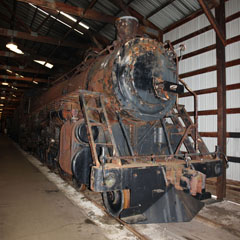
The Rock Island (Chicago Rock Island & Pacific) took delivery of fifty engines from Alco in 1910 numbered #895-#944, almost doubling its roster of Pacific type (4-6-2) locomotives. With 74" drivers, they were designed for fast passenger service.
Based on the P-31 4-6-2s delivered the year before, the new P-33 class had larger diameter fire tubes and was built with a superheater already installed (the P-31s were retrofitted with superheaters over the following years).
Originally built with 25" x 28" cylinders, the relatively small 45 sq ft grate could not produce the steam required and the cylinders were soon reduced to a more modest 23½" x 28". Some were later fitted with new cast-steel trailing trucks with 10,198 lb tractive-effort Delta boosters.
#938 is 80' 7" long and weighs 243,025 lbs, 151,500 lbs on its drivers. It has a 238 sq ft firebox and total heating surface of 3,690 sq ft, including 739 sq ft superheating. Operating at a boiler pressure of 185 psi, it delivered 32,859 lbs tractive effort.
#938 was donated for display on the grounds of Enid State School, a centre for handicapped children in Oklahoma, in 1954. By 1990, it had fallen into disrepair and was sold to the shortline Fort Worth & Western in Fort Worth, TX.
Related Links:
Illinois Railway Museum Website
Atchison Topeka & Santa Fe Railway Subjects
Burlington Route Historical Society
Friends of the Burlington Northern
Grand Trunk Western Historical Society
Illinois Central Railroad Historical Society
Milwaukee Road Historical Association
Norfolk & Western Historical Society
Pennsylvania Railroad Technical & Historical Society
Rock Island Technical Society
Santa Fe Railway Historical & Modeling Society
Southern Pacific Historical & Technical Society
Send a comment or query, or request permission to re-use an image.


